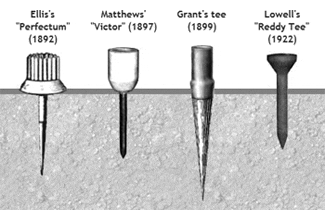The History Of The Golf Tee The history of the golf tee dates back to the 1500's. The practice of getting sand wet with a towel and mounding up earth to get the ball off the ground a little went on for some 300 years. The late 1800's changed all that. This is the...
The History Of The Golf Tee
The History Of The Golf Tee
The history of the golf tee dates back to the 1500’s. The practice of getting sand wet with a towel and mounding up earth to get the ball off the ground a little went on for some 300 years. The late 1800’s changed all that. This is the history of the golf tee.
The original rules of golf from 1744 state that your ball must be “teed” from the ground. Golfers where allowed to go within one club length of the original hole and use elements from the ground to tee it up. As time went on the game grew and there was a need to separate putting areas from teeing grounds. The first course to do this was St. Andrews when Old Tom Morris redesigned the course.
You could imagine the mess you had with just creating one tee. The wet towel and dirty hands gave way to the first golf tees. Golfers where in search of reuseable tees. Starting with paper then cork and rubber. The world’s first patented golf tee was invented by two Scots: William Bloxsom and Arthur Douglas. Their patent document is dated 1889 and describes a small rubber plate with a raised ball support in the form of upright prongs or a hollow cylinder. This tee sat up on top of the ground and became cumbersome in windy conditions. There had to be a way to fix it to the ground.
The first invention to stop your ball from rolling away was the “Perfectum” The Perfectum was patented in 1892 by Percy Ellis of Surrey, England. It was made of an iron spike base and round rubber pegs to hold the ball in place. The Perfectum was the first tee to be placed in the ground. In 1897, Scottish inventor PM Matthews patented a tee called the “Vector” with a metal spike and rubber cup to hold the ball which further held the ball in place.



The first really famous patent for a golf tee came from inventor Dr. George Grant. A dentist from the Boston area and one of the first black graduates from Harvard Dental School, Grant invented the first American wooden golf tee. The tee consisted of a wooden peg attached to a rubber tube with a cup on the top to hold the ball. Grant designed the tee to be less rigid at the top and more stable at the bottom. Grant didn’t announce , promote, or sell his work and was unnoticed for a long time. Although not the world’s first golf tee Grant was credited by the USGA in 1991 as the original inventor of the wooden golf tee.
The first patented and marketed tee was invented by another dentist named Dr. William Lowell. Dr. Lowell’s patented “Reddy Tee” is the first modern golf tee. The familliar one piece wooden peg with hollowed out top became the standard even today. Dr. Lowell even had golf great Walter Hagen advertising his invention.

Although there where many other golf tee inventions, these are the main ones. Technology has brought golf a long way and the golf tee is no exception. What’s next for the golf tee? It’s all up to the Rules of Golf.
Sources:
http://www33.brinkster.com/iiiii/inventions/tee.asp
Golf Digest – Oct. 2000 “Birth of a Tee” by Peter McDaniel

Mike Fay
PGA Director of Instruction
With over 30 years of teaching experience, it's easy to see why Mike has become a leader in the world of golf instruction. Everything from cutting edge social networking techniques to having his own podcast, Mike has helped to change the face of teaching golf. He currently is the Director of Instruction at Walnut Creek Country Club in South Lyon, Michigan.
Email: [email protected]
Backspin Archives
The History Of The Golf Tee
The Claret Jug
The Claret Jug The first British Open was contested in 1860 at Prestwick Golf Club and stayed there for some 11 years. Originally the winner of the British Open received something called the “Challenge Belt.” The Challenge Belt was created by the Earl of Eglinton. ...
TEAM MFG BLOG
Subscribe
Never miss a new post, article, or video!
Subscribe to our newsletter Chip Shots!





